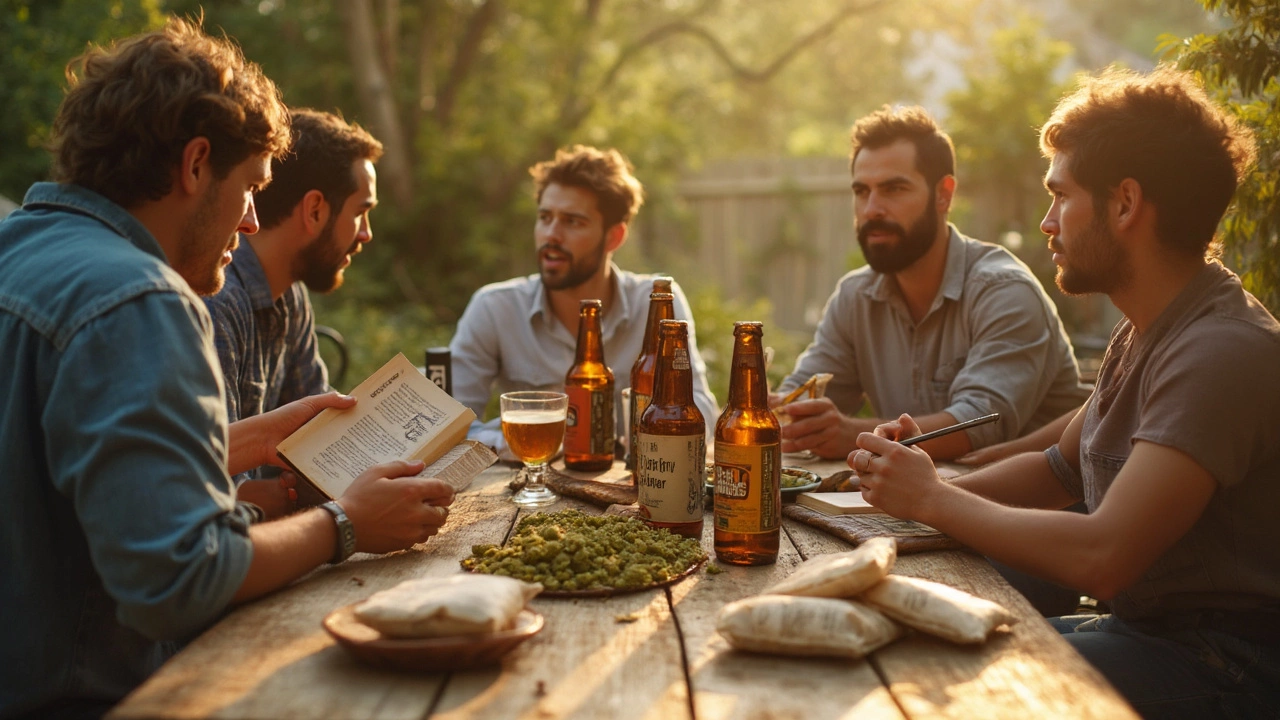Ever wonder if whipping up your own beer or wine at home in California could get you in hot water? Well, let’s clear things up: homebrewing is totally legal in California, as long as you’re making it for yourself, family, or friends, and not turning your kitchen into a secret bar. That said, the law comes with a few limits and “gotchas” you really need to know.
For starters, there’s a cap on how much you can make. If you’re making it alone, you can brew up to 100 gallons a year. Got another adult brewer at home? You two can crank out up to 200 gallons together. But selling your homebrew? That’s a hard no. The moment money changes hands, things turn illegal really fast.
And here’s something a lot of folks miss: your homebrew has to stay off commercial property, so no serving it at your business, restaurant, or local pop-up. It’s all about personal use. Those home brewing kits you see everywhere are totally fine, though—no hoop-jumping or secret licenses for that in California, as long as you follow the basic rules.
- California Law: The Real Story
- What You Can and Can’t Do with Homebrewing
- Tips to Stay Legal (And Out of Trouble)
- Fun Facts: California’s Brewing Scene
California Law: The Real Story
California actually makes it pretty straightforward for anyone thinking about homebrewing. The state follows the federal rules that popped up after the Prohibition era finally ended. The main idea is simple: you’re allowed to brew your own beer or wine at home, as long as you’re not trying to act like a business selling booze without a license.
The golden rule? Homebrewing is for personal use only—think enjoying your own creations, sharing with your family, and having friends over for tastings. But the law is clear that selling what you make is off-limits. If you’re caught selling even a bottle to a buddy, you could be in for a nasty fine or worse. And yes, that applies if you’re "donating" but expecting a tip or compensation.
Here’s a quick look at the main numbers you need to know:
| Who’s Brewing | Max Gallons Allowed Per Year |
|---|---|
| Single adult (21+) | 100 gallons |
| Household (2+ adults, 21+) | 200 gallons |
One thing that surprises a lot of new brewers is how easy it is to stay within the rules. You don’t need a special permit or paperwork in California to use a homebrewing kit. Just stick to personal use, keep your annual batch under the limit, and you’re golden.
But here’s something a lot of people don’t realize: moving your beer or wine off your property—for example, bringing a keg to a party at a community center—can be a gray area. State law allows you to take homebrew to certain organized tastings, competitions, or club meetings, but you have to play by their rules. Always double-check with organizers so you don’t accidentally break the law. And remember, you must be 21 or older to participate—no exceptions.
What You Can and Can’t Do with Homebrewing
There are some clear rules when it comes to homebrewing in California. Most of it makes sense once you actually see it laid out. Here’s how it works.
- homebrewing is legal for folks 21 and older (yep, no beer for the teens, even if it’s homemade).
- You can make beer, wine, cider, or mead for personal or family use. Sharing with friends is fine—but only if you’re not charging them or running a club that’s really just a secret bar.
- If you’re the only adult in the house, 100 gallons per year is your limit. With another adult, that bumps up to 200 gallons total for the household.
- Don’t even think about selling your homebrew. The second you take cash or trade beer for services, you’re in violation of both state and federal law.
- Transporting homebrew outside your house is totally fine for “personal or family use”—like packing some bottles for a picnic or dropping off a few for a friend’s barbecue. But serving it in a business? That’s illegal, no way around it.
Competitions? Go for it! California gives a pass for entering homebrew contests or tastings, as long as you’re not making money off it. A hobbyist can show off their skills, but not run a side hustle.
Quick look at the basics:
| Homebrewing Activity | Legal? |
|---|---|
| Brew at home (21+) | Yes |
| Share with friends/family for free | Yes |
| Sell your homebrew | No |
| Make more than 200 gallons/year (household) | No |
| Use in commercial settings | No |
| Enter competitions for fun | Yes |
So, as long as you stick to these main points, you’re good. Don’t overthink it: make enough for you and your friends, skip the sales pitch, and steer clear of trying to run a “brew pub” from your garage. The state’s not out to bust hobbyists, but they expect you to stay within the lines.

Tips to Stay Legal (And Out of Trouble)
Staying on the right side of the law with homebrewing in California isn’t rocket science, but it does mean paying attention to a few key details. If you’re planning to fire up that next batch, keep these tips in mind so you don’t give yourself an unnecessary headache.
- Homebrewing is strictly for personal enjoyment. You can’t sell it. Sharing with friends or family at home? Totally fine. Selling even a pint at a garage sale is asking for trouble.
- Stick to the limits: If you live alone, 100 gallons per calendar year is your cap. Two adults in a home can go up to 200 gallons. This isn’t a suggestion—these numbers are right from state and federal law.
- Keep your brew at home or with you. Taking it to bars, restaurants, or clubs to serve isn’t allowed. Entering your beer in a homebrew competition? That’s cool, as long as there’s no cash involved and it follows the event’s rules.
- If you want to serve homebrew at a special event or festival, sometimes you need a temporary event permit—so always double-check with local city or county officials before loading up your keg.
- Those under 21 can help out with the process (like bottling), but they can’t drink a drop. This applies even if it’s your own kid lending a hand.
Here’s a quick cheat sheet for the numbers and dos/don’ts:
| Rule | What’s Allowed | What’s Not |
|---|---|---|
| Annual Brewing Limit | 100 gallons (1 adult) 200 gallons (2+ adults) | Going over this amount |
| Serving | Home, private parties, non-profit comps | Businesses, sales |
| Age Limits | 21+ to drink | Under 21 drinking |
| Selling | Never | Any exchange for money, anytime |
One more thing: California doesn’t make you register your setup or get a license for personal homebrewing, so you can buy a kit and get started with zero paperwork. If you ever want to go commercial, though, you’ll need to deal with the authorities and stack up a bunch of forms and fees.
Fun Facts: California’s Brewing Scene
California’s got a wild brewing history. The state is a powerhouse in the craft beer world, holding the record for the most breweries of any state. As of 2024, there were over 1,400 active breweries across California. That’s more than Texas and New York combined! So if you’re homebrewing here, you’re in some pretty impressive company.
Did you know that the West Coast IPA, now a global favorite, was actually born in California? Brewers here set that trend, making hoppy, bold beers a thing. Today, a lot of homebrewers try to recreate those classic flavors with their own kits—sometimes even competing in local contests just for bragging rights.
If you’re curious what parts of California love brewing the most, check this out:
| City | Number of Breweries (2024) |
|---|---|
| San Diego | over 150 |
| Los Angeles | about 100 |
| San Francisco Bay Area | 130+ |
The homebrewing scene here isn’t just massive; it’s super connected. Clubs like the Maltose Falcons (founded in 1974) are some of the oldest homebrew clubs in the country, hosting events, sharing recipes, and helping newbies avoid rookie mistakes. Plus, California’s Homebrew Act, signed in 1978, made it one of the first places in modern America to welcome homebrewers legally.
- California was front and center in the 1970s legal push to make homebrewing legit again in the US, after Prohibition killed it off for decades.
- Homebrewing supply shops are easy to find here—there’s probably one a short drive away from most people in big cities.
- Every summer, local fairs often hold amateur brewing contests, so you can show off your creations and maybe snag a ribbon.
If you’re looking for a place where homebrewing is respected, celebrated, and even a little competitive, California is hard to beat. No surprise that homebrewing is a mainstay hobby here.


